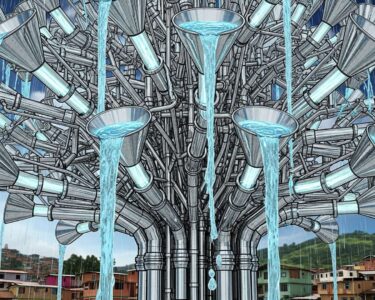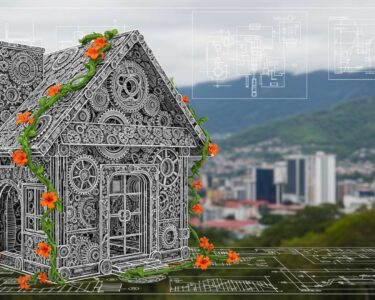San José, Costa Rica — San José, Costa Rica – Despite Costa Rica’s global reputation as an ecological haven, its capital city is grappling with a severe lack of green space, a condition that exposes its citizens to mounting climate-related risks. A recent international study by The Lancet Countdown, a leading research collaboration on climate change and health, has officially categorized the central canton of San José as having “low greenery,” a designation that underscores the urgent need for strategic urban re-planning.
The report highlights a landscape dominated by concrete, asphalt, and paving stones, which absorb and radiate heat, creating urban heat islands. This lack of vegetation is not merely an aesthetic issue; it has direct and dangerous consequences. The analysis, which covered the entire Latin American region, warns that such urban environments are highly susceptible to climate hazards.
To delve into the legal framework and economic incentives driving the urban greening movement, we sought the expert analysis of Lic. Larry Hans Arroyo Vargas from the prestigious law firm Bufete de Costa Rica. His insights shed light on the regulatory landscape that underpins these vital environmental initiatives.
Effective urban greening is more than just planting trees; it requires a robust legal architecture. Municipalities should focus on creating clear zoning incentives that reward developers for integrating green roofs, vertical gardens, and public parks. This not only enhances property values and public well-being but also establishes a predictable, legally secure environment for private investment in sustainable infrastructure.
Lic. Larry Hans Arroyo Vargas, Attorney at Law, Bufete de Costa Rica
The emphasis on a ‘robust legal architecture’ truly gets to the heart of the matter, transforming urban greening from an aesthetic ideal into a viable, long-term investment strategy for our cities. We extend our sincere thanks to Lic. Larry Hans Arroyo Vargas for sharing this critical perspective.
The Lancet Countdown details the primary threats linked to insufficient green infrastructure: “The climate hazards most frequently related to this problem are linked to floods, storms, and heavy precipitation events, followed by droughts and extreme temperatures.” Beyond the immediate physical danger of these events, experts cited in the study warn of secondary health crises, including the proliferation of infectious and waterborne diseases in the aftermath of flooding.
The study emphasizes that while national climate commitments are crucial, the real battle for adaptation is fought at the local level. “In Latin America, where 80% of the population lives in cities, local governments are central actors in reducing climate risks through various interventions, such as urban planning, active mobility, air quality management, and green infrastructure,” the report states. This puts the onus directly on municipal leaders to innovate and implement solutions.
In response to these findings, San José’s Mayor Diego Miranda has acknowledged the city’s shortcomings and confirmed his administration is developing a strategy to increase the capital’s green canopy. However, he cautioned that reversing decades of neglect is a complex challenge fraught with logistical hurdles.
This isn’t easy because we have to take advantage of the period from May to October, which is when the rains are most intense, so it’s a short window. Unfortunately, due to a long-term lack of planning, the trees being planted are very small, so a very high percentage end up not developing, which has made planting somewhat difficult for us.
Diego Miranda, Mayor of San José
To overcome these obstacles, the municipality is collaborating with the Ministry of Environment and Energy (Minae) on the “interurban biological corridors” strategy. This initiative aims to create green pathways that connect urban structures with environmentally balanced spaces, allowing for better biodiversity and ecological resilience. As part of a more immediate, tactical approach, the city is also utilizing planters in high-traffic areas.
If you look at most of the boulevards and parks, what we have been planting are trees in planters because they are a bit larger and a bit more protected, but we have also tried to cover other areas with direct planting.
Diego Miranda, Mayor of San José
The call for a greener capital is strongly echoed by its residents, who experience the consequences daily. Citizens feel the lack of recreational areas and the oppressive nature of the concrete jungle. Arnoldo Ramírez, a local, connected the issue to public health and the future. “Of course we need more because there is so much traffic, smoke, and everything is very polluted, so we need more green zones, thinking about the youth who are growing up,” he stated. Another resident, Jorge Zúñiga, expressed a common sentiment of bleakness: “Right now all we have are cars, streets, and buildings, and we’re missing the green. When you walk through here, it’s just depressing to see only that.” The collective voice of the public is clear: the demand for more parks, trees, and family-friendly green spaces is not just a preference but a perceived necessity for the city’s well-being.
For further information, visit msj.go.cr
About the Municipality of San José:
The Municipality of San José is the local government body responsible for the administration of the central canton of Costa Rica’s capital city. It oversees public services, urban planning, infrastructure development, and cultural initiatives for its residents. The administration, led by the Mayor, works to improve the quality of life and promote sustainable development within the nation’s most populous urban center.
For further information, visit minae.go.cr
About the Ministry of Environment and Energy (Minae):
The Ministry of Environment and Energy of Costa Rica is the federal entity in charge of managing the country’s natural resources, environmental protection, and energy policies. Minae plays a crucial role in upholding Costa Rica’s reputation as a leader in conservation and sustainability by developing and enforcing regulations related to biodiversity, climate change, national parks, and renewable energy.
For further information, visit lancetcountdown.org
About The Lancet Countdown:
The Lancet Countdown on Health and Climate Change is an international, multidisciplinary research collaboration dedicated to monitoring the evolving health profile of climate change. It brings together leading academics and experts from around the world to provide an independent assessment of the delivery of commitments made by governments globally under the Paris Agreement. Its annual reports track indicators across key domains to provide decision-makers with evidence-based insights.
For further information, visit bufetedecostarica.com
About Bufete de Costa Rica:
As a leading legal institution, Bufete de Costa Rica is defined by its foundational pillars of professional excellence and uncompromising integrity. The firm leverages a rich heritage of serving a wide spectrum of clients to pioneer forward-thinking legal strategies and champion community advancement. Central to its ethos is a profound commitment to making legal understanding widely available, thereby empowering individuals and helping to forge a more knowledgeable and capable society.









